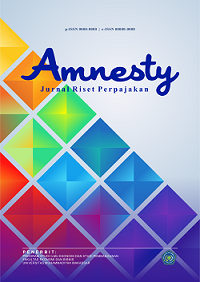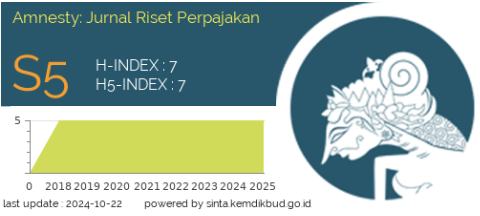Evaluation of E-Bupot Unification System Based on Taxpayer Perspective
Abstract
State revenue from taxes can be said to be the largest source of income for Indonesia. Therefore, in order to achieve the increasing tax revenue target, the government made updates to the tax system, namely E-Bupot Unifikasi. The evaluation was conducted to analyze whether the existing development makes it easier for taxpayers to report their taxes and whether the e-Bupot Unification system is more efficient and effective than e-Bupot 23/26. The evaluation is based on the TAM (Technology Acceptance Model) and DSS (DeLone and McLean IS Success Model) models. In this study, the object of research was conducted on taxpayers (clients of PT OCT and PT OCT). The results of evaluating the effectiveness of the e-Bupot Unification system as measured by the TAM and DSS models based on the perceptions of PT OCT clients show that the e-Bupot Unification system as a whole is effective. This is based on the ability of the Unification e-Bupot system to assist users in reporting their taxes. Meanwhile, from the perception of PT OCT is Bukti Potong Unifikasi as a result of the e-Bupot Unifikasi system received from each client as a whole has not shown an increase in its effectiveness to credit PT OCT tax from the previous e-Bupot system. The implication of this research is that improvements to the e-Bupot Unification system can be made and by considering other types of taxes such as Income Tax 21 to be reported in the e-Bupot Unification system so that in the future it can make it easier for taxpayers to report their taxes. Taxpayers who are deducted are expected to report according to the invoice period issued by the opposite transaction, provide notifications every month periodically so that customers provide Proof of Deduction in the same period as the invoice, make manual calculations of Income Tax, include clear, complete, and updated information.
References
Ardianti, P.N.H., Sanjaya, K.R. (2022). Peningkatan Sistem Pencatatan Kelengkapan Data Mandor & Pegawai untuk Pelaporan Pajak dengan Sistem PPh Unifikasi di PT. Citra Exact Engineering. Jurnal Inovasi Akuntansi (JIA) Volume 1 Nomor 2, (November 2022).
Arianty, F. (2023). E-Bupot Unification as an Application to Fulfill Tax Obligations for Tax Witholder. MDPI, (January 2023).
Budiarso, N.S., Datu, C.V., & Tangka, M.O.J. (2022). Analisis Pelaksanaan Kewajiban Perpajakan PPh Pasal 4 Ayat (2) Atas Kegiatan Sewa Tanah dan/atau Bangunan Pada PT. Pegadaian Kanwil V Manado. Jurnal Ekonomi dan Bisnis Digital Volume 2 Nomor 1, (2023).
Dessyanti. (2021). Evaluasi Penerapan E-Faktur 3.0 Sebagai Sarana Pelaporan Masa PPN (Studi Kasus Pada KPP Depok Cimanggis). Universitas Indonesia.
Hutagalung, G.T. (2022). Evaluasi Penerapan E-Faktur 3.0 Pada KPP Pratama Jakarta Mampang Prapatan. Universitas Indonesia.
Kurniawan, A., Mulyati, S., & Wati, K.M. (2019). The Effect of e-SPT and National Tax Census on The Income of Income Tax (Case Study in West Java Regional Tax Office 1). Journal of Accounting and Business Issues (JABI).
Lubis, N.R. (2022). Evaluasi Sistem E-Bupot Berdasarkan Perspektif Tenant (Studi Kasus Pada PT XYZ). Universitas Indonesia.
Nofianus, K. (2022). Evaluasi Terhadap Hilangnya Hak Pengkreditan Pajak Masukan Berdasarkan Aspek Ease of Administration dan Proporsionalitas). Universitas Indonesia.
Putri, R.N. (2019). Analisis Penerimaan Pengguna Aplikasi Mobile AIS Menggunakan Technology Acceptance Model (TAM) dan D&M IS Success Model.). Universitas Islam Negeri Syarif Hidayatullah.
Siswanto, V.A (2012). Strategi dan Langkah – Langkah Penelitian. Yogyakarta: Graha Ilmu.
Widi, R.K (2010). Asas Metodolodi Penelitian. Yogyakarta: Graha Ilmu.




